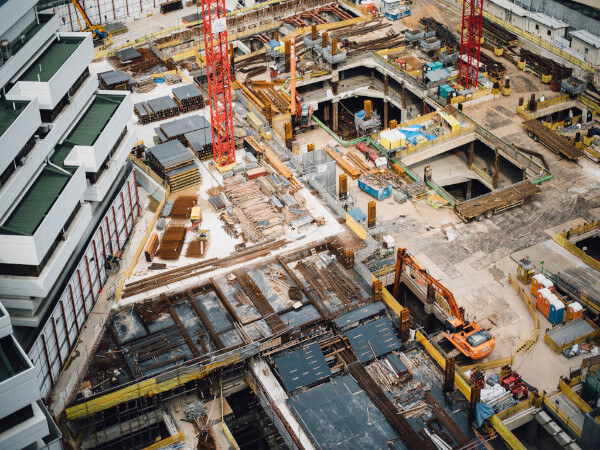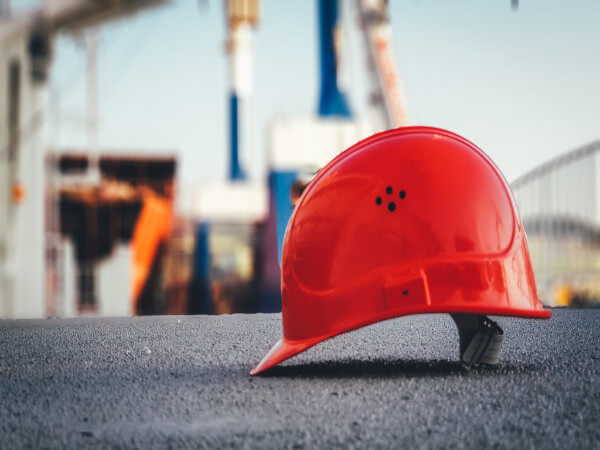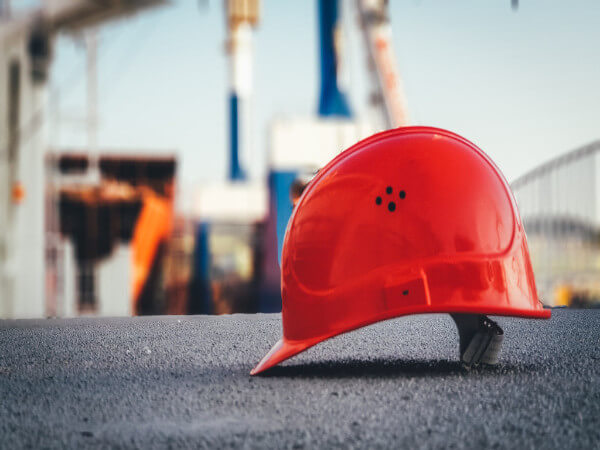Doosan Infracore North America is breaking the final ties with former sister company Doosan Bobcat with a new line of compact excavators for the U.S. in 2022.
Four models, ranging from 2.7 to 5.5 tons, will arrive in the first quarter after being produced in South Korea, where Doosan is based. The models will replace Bobcat-made compact excavators, as well as break new ground in the U.S. for Doosan Infracore. (Videos of the new compact models in action are posted at the end of this story.)
More sizes are planned, including a 4-ton model next fall and 1.7- and 1.9-ton models in 2023. The company’s 6- and 8-ton excavators will be upgraded next year as well. And an electric compact excavator shown last year as a prototype at ConExpo will be hitting the market in mid-2023, according to Aaron Kleingartner, Doosan product and dealer market manager.
Within two years, the entire Doosan-built excavator lineup in the U.S. will extend from 1.7 to 100 tons, Kleingartner said.
Compact excavators unveiled
Doosan rolled out three of its new -7 compact excavators – the DX27Z-7, DX35Z-7 and DX50Z-7 – at a recent media event at the company’s testing grounds in Tucson, Arizona.
The displayed machines were all zero tail swing. A DX55R-7 model is also due out next year that will be reduced tail swing. Conventional tail swing versions will be available as well, the company says.
Features include full glass door and metal frame on the cab exterior for operator visibility, a powerful heating and air system, and Bluetooth radio, Kleingartner said. The excavators are also available with an open, instead of enclosed, cab.
For the first time, DoosanConnect telematics will come standard on the machines. Steve Americano, product manager for mini excavators, said the system includes geofencing that will send an alert if the machine moves outside of the geofence’s radius, which can be set by the owner.
The compact excavators have a new operator platform that insulates the cab from engine heat, Americano said. An auto-shift function automatically shifts engine speed depending on the terrain. All engines are Doosan.
The standard arm for the excavators is 43 inches. An optional 51-inch arm is available.
Hydraulic flow can be adjusted from the cab to handle various attachments. The machines come equipped with connectors needed for a hydraulic quick coupler.
Options include a rearview camera, LED lights and additional counterweight for handling heavier attachments.
These machines come with a one-year, 1,500-hour warranty. There is also a three-year, 5,000-hour powertrain warranty that “covers pumps, motors, all the high dollar components,” Americano said.
Phasing in Doosan-built excavators
Doosan Infracore was sold by parent company Doosan Heavy Industries & Construction to fellow South Korean company Hyundai Construction Equipment earlier this year. Doosan Infracore and Doosan Bobcat have supplied excavators to each other through a dual-brand agreement.
Bobcat provided 3-, 4- and 5-ton excavators that were branded Doosan, and Doosan provided Bobcat with 14- and 17-ton excavators that were branded Bobcat, according to Doosan CEO Edward Song.
Bobcat was not part of the Hyundai purchase and remains under the Doosan Heavy umbrella. Doosan Infracore is now part of the newly created Hyundai Genuine subsidiary along with Hyundai Construction Equipment.
After the new Doosan compact excavators come out, only a 4-ton model will be a Bobcat machine. Song said that the 4-ton model will also be replaced in the third quarter of 2022 with a Doosan-built excavator. Song noted that Doosan has the capability and experience with excavators under 5 tons in Korea and in European markets.
The move toward Doosan-branded compact excavators for the U.S. began in 2018 when Doosan Infracore North America and Doosan Bobcat separated their businesses, Song said. Doosan Infracore plans to capture some of the growing compact excavator market, as well as give its dealers a broader range of equipment.
“We will be bringing those machines in from our design teams in our factories in Korea next year,” said Kleingartner. “They are completely Doosan designed and manufactured.”
closer look
Here are some highlights and specs of each of the three models shown recently at Doosan Infracore North America’s testing grounds and expected to arrive in the first quarter of 2022:
DX27Z-7
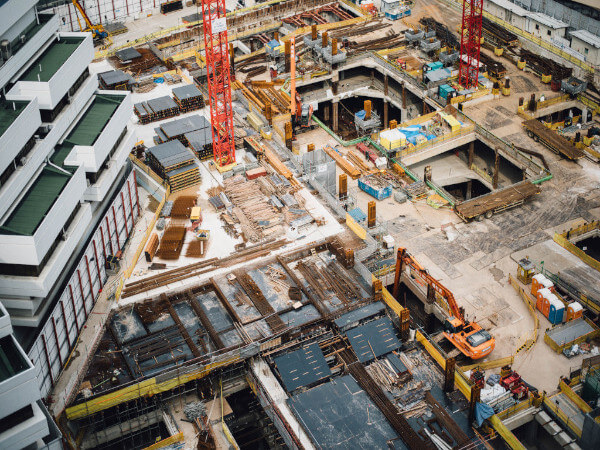
Doosan DX27Z-7 compact excavatorDoosan Infracore North AmericaHighlights: At 6,000 pounds, it represents a new size class for Doosan’s North American lineup. A new rearview camera provides a 360-degree view. Other features include a 3-foot 7-inch standard thumb-ready arm and an 11.8-inch rubber track undercarriage. The excavator is 60 inches wide. Standard attachments include a bucket, quick coupler and thumb. Second auxiliary hydraulics are an option.
Horsepower: 24.7Operating weight: 6,168 lbs. Maximum digging depth: 8 ft. 8 in. Maximum digging reach (ground): 14 ft. 10 in. Maximum loading height: 10 ft. 1 in.
DX35Z-7
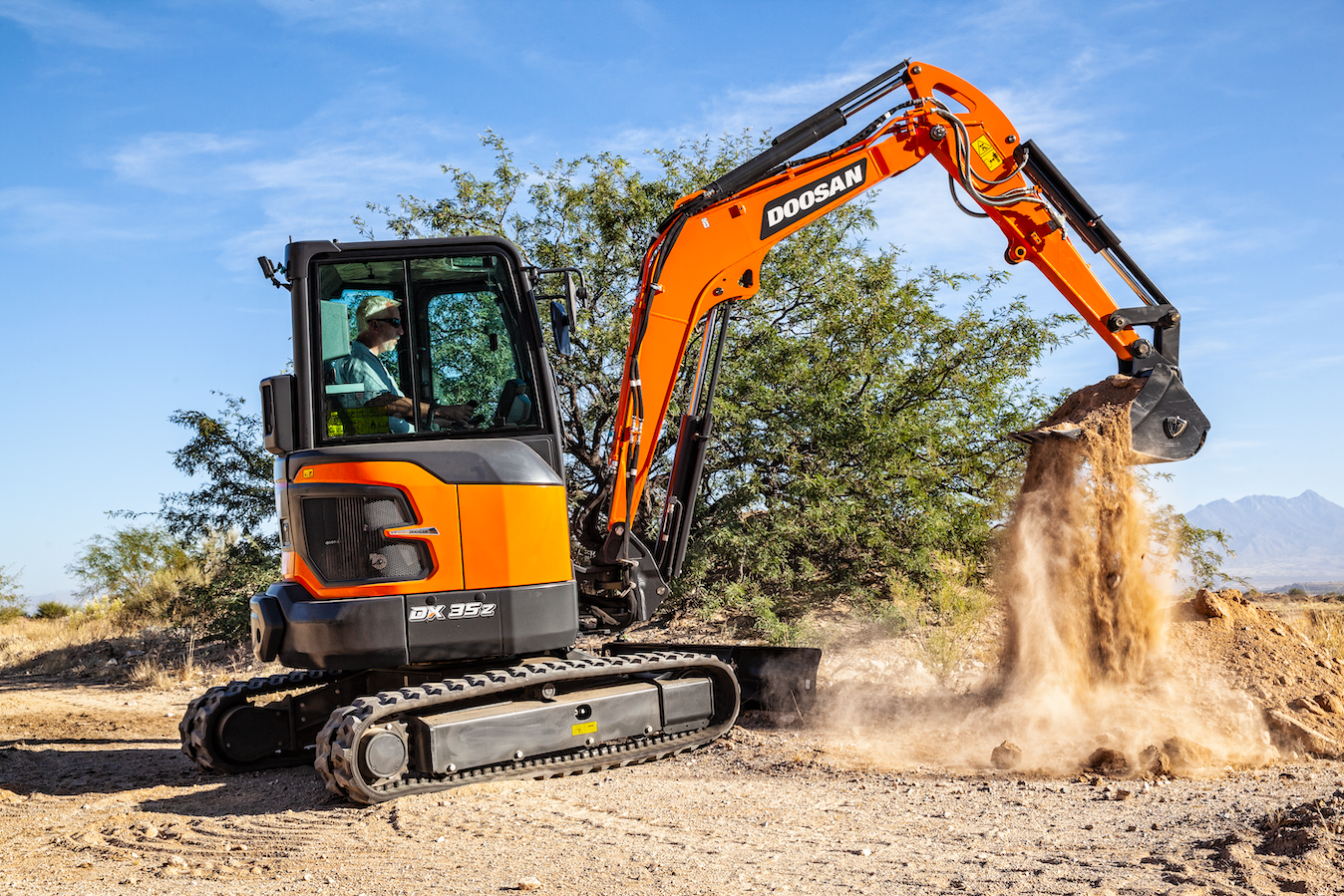
Doosan DX35Z-7 compact excavatorDoosan Infracore North AmericaHighlights: Zero tail swing design with a rounded shape for tight jobsites. Also includes auxiliary hydraulic flow, wider cabin, LED lamp, enclosed cab with HVAC and 5.7-inch color LCD monitor. Options: rearview camera, cast counterweight, second auxiliary hydraulics and longer arm.
Horsepower: 24.7Operating weight: 8,807 lbs. Maximum digging depth: 11 ft. 4 in. Maximum digging reach (ground): 17 ft. 9 in. Maximum loading height: 12 ft. 2 in.
DX50Z-7
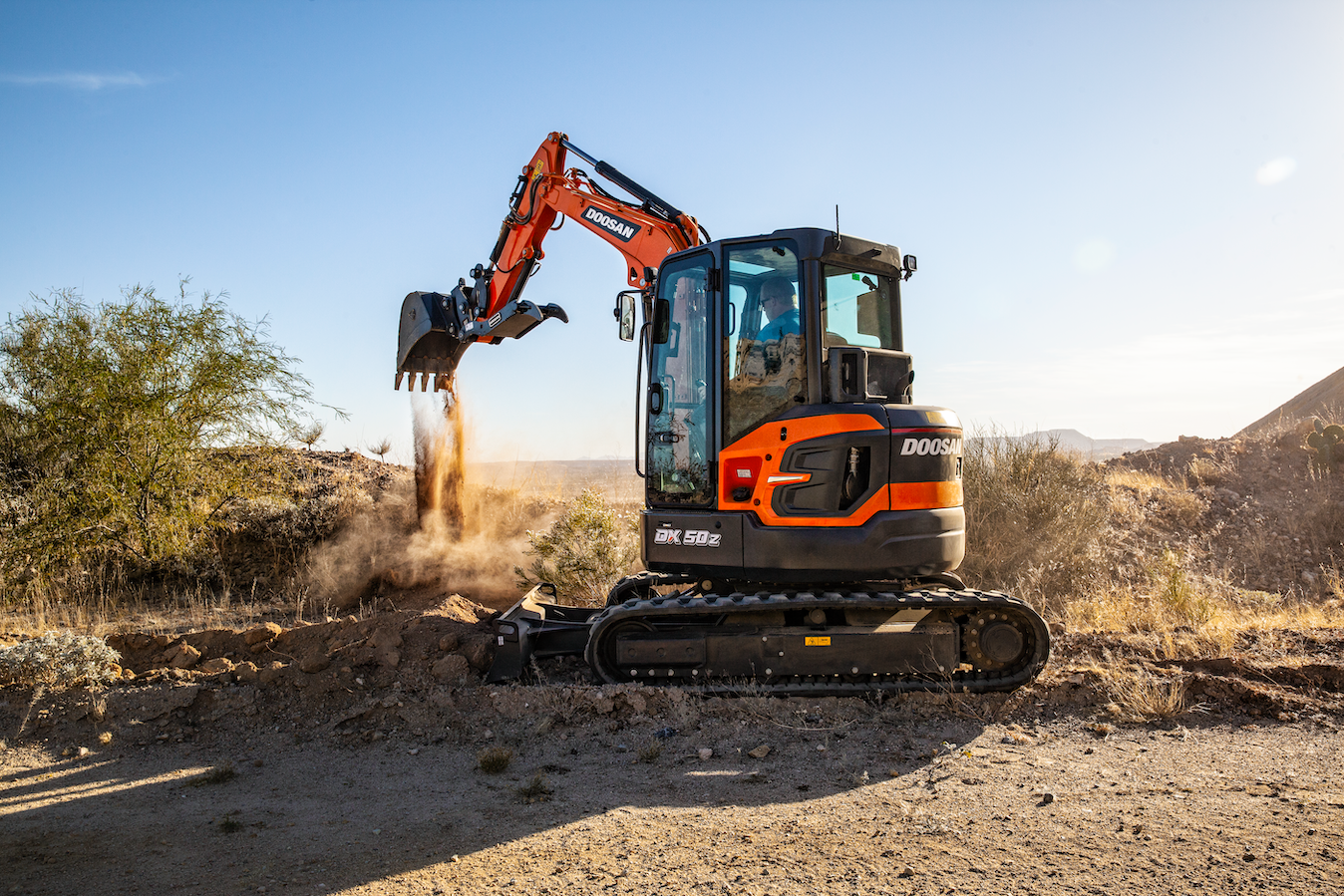
Doosan DX50Z-7 compact excavatorDoosan Infracore North AmericaHighlights: Zero tail swing, standard enclosed cab with HVAC and standard attachments of bucket, quick coupler and thumb. Options include heated, adjustable seat and steel tracks.
Horsepower: 48.8 Operating weight: 12,121 lbs. Maximum digging depth: 11 ft. 5 in. Maximum digging reach (ground): 19 ft. Maximum loading height: 12 ft. 6 in.
Excavators in action
The following two videos are of Doosan’s new DX35Z-7 compact excavators shot during a media event at the company’s testing grounds near Tucson, Arizona. The excavator in the background is the enclosed-cab version.
CMSBrowserComponents.load({ el: ‘#vue-1638987291323-483’, name: ‘OEmbed’, props: {“mountPoint”:”/__oembed”,”url”:”https://youtu.be/svg5kjFY9VE”,”attrs”:{“type”:”oembed”,”id”:”https://youtu.be/svg5kjFY9VE”,”element”:”aside”}}, hydrate: false });
CMSBrowserComponents.load({ el: ‘#vue-1638987291323-847’, name: ‘OEmbed’, props: {“mountPoint”:”/__oembed”,”url”:”https://youtu.be/r-wmUTcHg6Q”,”attrs”:{“type”:”oembed”,”id”:”https://youtu.be/r-wmUTcHg6Q”,”element”:”aside”}}, hydrate: false });

